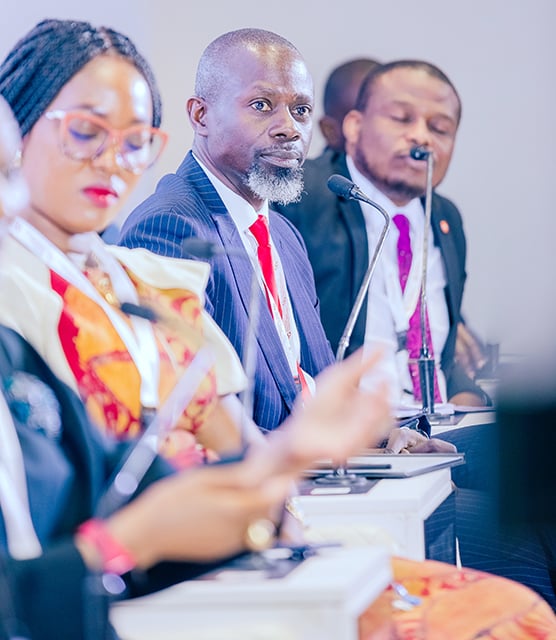Human capital repositioning seen as catalyst for Africa’s economic transformation – African Business

Report on the Strategic Imperative of Human Capital for Africa’s Sustainable Development
Introduction: Aligning Human Resources with the Sustainable Development Goals
A high-level session at the African Forum for Talent Leadership in Finance, co-hosted by the African Export-Import Bank (Afreximbank) and the Alliance of African Multilateral Financial Institutions (AAMFI), concluded that the strategic management of human capital is essential for Africa to achieve its industrialisation and integration objectives. Experts repositioned the role of Human Resources (HR) as a critical driver for attaining the Sustainable Development Goals (SDGs), particularly those related to economic growth, education, and well-being.
Elevating HR to a Strategic Partner for SDG 8 and SDG 9
The forum asserted that for Africa to realise its potential in line with SDG 8 (Decent Work and Economic Growth) and SDG 9 (Industry, Innovation, and Infrastructure), the HR function must evolve from an administrative role to a strategic one. This transformation is necessary to drive business success and sustainable economic transformation.
Key Strategic Shifts for HR Leadership
- Proactive Engagement: Pai Gamde, Chief Talent Officer at Coronation Group, argued that HR must proactively integrate into the core business system rather than waiting for an invitation to strategic discussions.
- Measurable Outcomes: The relevance of HR must be demonstrated through data-driven, measurable outcomes that contribute directly to organisational performance, innovation, and cost reduction, as noted by Jatto Cyril of Alpha Morgan Bank.
- Business Acumen: Allan Akoko, Group Director of Human Resources at the African Guarantee Fund, stressed that HR leaders must understand organisational profit models to gain credibility and contribute effectively to strategic growth.
- Accountability for Transformation: Moderator Peter Okwoche concluded that HR leaders must own their role in transformation by demonstrating tangible business value, thereby earning their place in key decision-making processes.
Addressing the Skills Gap to Advance SDG 4 and SDG 8
A significant challenge identified was the persistent skills gap across the continent, which directly impedes progress on SDG 4 (Quality Education) and SDG 8. Constantine Wafula, Acting Head of HR at the East African Development Bank, highlighted the mismatch between educational outcomes and market demands as a critical barrier to developing a competitive workforce.
Recommendations for Bridging the Capability Gap
- Multi-stakeholder Collaboration: Forge stronger partnerships between governments, universities, and the private sector to align educational curricula with the skills required for modern industries. This directly supports SDG 4.4, which aims to increase the number of adults with relevant skills for employment.
- Enhancing Labour Mobility: Strengthen frameworks to facilitate talent movement across African borders, creating a more dynamic and integrated regional workforce. This fosters collaboration in line with SDG 17 (Partnerships for the Goals).
- Commitment to Lifelong Learning: Champion ecosystems that promote continuous learning and adaptation to anticipate future workforce requirements in an era of rapid technological change.
Fostering Well-being and Resilience in Support of SDG 3
The forum recognised the post-pandemic emphasis on employee well-being as a strategic imperative, aligning corporate responsibility with SDG 3 (Good Health and Well-being). Allan Akoko noted that empathy and a focus on employee wellness are no longer peripheral concerns but are central to attracting and retaining talent, fostering innovation, and building resilient organisations.
Integrating Wellness into Corporate Strategy
- Prioritising employee experience and mental health as a core business strategy to enhance productivity and innovation.
- Viewing investment in human capital not as an administrative cost but as a strategic asset essential for sustainable growth and competitiveness.
Conclusion: Human Capital as the Engine for Africa’s Sustainable Future
The session concluded with a unified call for continuous investment in human capital development, data-driven HR strategies, and enhanced leadership accountability. Repositioning HR as a strategic partner is fundamental to unlocking Africa’s economic potential. By harnessing the skills and creativity of its people, the continent can accelerate progress towards the Sustainable Development Goals, ensuring that its journey towards industrialisation, digitalisation, and regional integration is both inclusive and sustainable.
Analysis of Sustainable Development Goals in the Article
-
Which SDGs are addressed or connected to the issues highlighted in the article?
The article addresses several Sustainable Development Goals (SDGs) by focusing on human capital as a critical driver for economic transformation in Africa. The following SDGs are most relevant:
- SDG 8: Decent Work and Economic Growth: This is the central theme of the article. The entire discussion revolves around “unlocking the full potential of the workforce” to drive “sustainable growth,” “industrialisation,” and “regional integration.” It emphasizes enhancing “employee productivity” and making HR a strategic partner in achieving “business success,” which are core components of SDG 8.
- SDG 4: Quality Education: The article directly connects to this goal by highlighting the “capability gap across Africa’s workforce” and the “persistent mismatch between educational outcomes and the skills required by the market.” The call for “stronger collaboration with governments and universities to align training curricula with modern workplace realities” and the emphasis on “lifelong learning” are central to achieving quality and relevant education.
- SDG 9: Industry, Innovation and Infrastructure: The article frames the discussion within the context of Africa positioning itself for a “new era of industrialisation, digitalisation and regional integration.” It argues that developing human capital is “essential” for this transformation, thereby linking the workforce’s skills and productivity directly to the continent’s ability to build resilient infrastructure and foster innovation.
- SDG 3: Good Health and Well-being: The article explicitly mentions the growing importance of employee welfare. It notes that the pandemic brought “employee wellness, resilience and empathy to the forefront of leadership agendas” and states that “Wellness and empathy are now strategic imperatives,” connecting workplace strategy to the broader goal of promoting well-being.
-
What specific targets under those SDGs can be identified based on the article’s content?
Based on the issues discussed, the following specific SDG targets can be identified:
- Target 4.4 (under SDG 4): “By 2030, substantially increase the number of youth and adults who have relevant skills, including technical and vocational skills, for employment, decent jobs and entrepreneurship.” This target is directly addressed through the article’s focus on closing the “capability gap” and resolving the “mismatch between educational outcomes and the skills required by the market.” The goal is to create a workforce with skills that are aligned with “modern workplace realities.”
- Target 8.2 (under SDG 8): “Achieve higher levels of economic productivity through diversification, technological upgrading and innovation…” The call for HR to use “data-driven solutions that improve performance,” drive “innovation,” and support “organisational transformation” directly supports this target of increasing economic productivity.
- Target 8.5 (under SDG 8): “By 2030, achieve full and productive employment and decent work for all…” The article’s overarching goal of “unlocking the full potential of the workforce” and ensuring that investments in people lead to “measurable business results” aligns with the aim of achieving productive employment. The focus on “employee experience and wellbeing” also contributes to the “decent work” aspect of this target.
- Target 3.4 (under SDG 3): “By 2030, reduce by one third premature mortality from non-communicable diseases through prevention and treatment and promote mental health and well-being.” The article’s emphasis on “employee wellness” and “empathy” as “strategic imperatives” directly relates to the promotion of mental health and well-being within the workplace, which is a key component of this target.
-
Are there any indicators mentioned or implied in the article that can be used to measure progress towards the identified targets?
The article does not mention official UN indicators, but it strongly implies the need for measurement and provides examples of metrics that organizations should use. The emphasis is on making HR’s contribution visible through “measurable outcomes.”
- Implied Indicators for Target 8.2 & 8.5: The article repeatedly calls for data to prove HR’s value. It mentions using “data-driven solutions that improve performance or reduce costs,” which implies indicators such as:
- Employee productivity rates
- Employee attrition/retention rates
- Metrics showing cost reduction due to HR initiatives
- Measures of return on investment (ROI) for human capital development programs
The statement, “We must demonstrate that investing in people translates into measurable business results,” encapsulates this idea.
- Implied Indicators for Target 4.4: The discussion of the “capability gap” and the “mismatch between educational outcomes and the skills required by the market” implies the need for indicators that measure the alignment between education and industry. These could include:
- Graduate employment rates in relevant fields
- Employer satisfaction surveys regarding the skills of new hires
- Metrics tracking the number of partnerships between universities and private sector companies
- Implied Indicators for Target 3.4: The focus on “employee wellness” as a “strategic imperative” suggests that progress would be measured through indicators like:
- Employee well-being and satisfaction surveys
- Rates of absenteeism or sick leave
- Uptake of employee assistance and mental health support programs
- Implied Indicators for Target 8.2 & 8.5: The article repeatedly calls for data to prove HR’s value. It mentions using “data-driven solutions that improve performance or reduce costs,” which implies indicators such as:
-
Create a table with three columns titled ‘SDGs, Targets and Indicators” to present the findings from analyzing the article. In this table, list the Sustainable Development Goals (SDGs), their corresponding targets, and the specific indicators identified in the article.
SDGs Targets Indicators (Mentioned or Implied in the Article) SDG 8: Decent Work and Economic Growth Target 8.2: Achieve higher levels of economic productivity. Target 8.5: Achieve full and productive employment and decent work.
- Employee productivity rates
- Employee attrition/retention rates
- Cost reduction metrics from HR initiatives
- “Measurable business results” from investing in people
- Metrics on employee experience and wellbeing
SDG 4: Quality Education Target 4.4: Increase the number of youth and adults with relevant skills for employment. - Metrics measuring the “capability gap”
- Metrics tracking the alignment of training curricula with market needs
- Graduate employment rates
SDG 3: Good Health and Well-being Target 3.4: Promote mental health and well-being. - Metrics related to “employee wellness”
- Employee satisfaction surveys
- Data on employee resilience and empathy
SDG 9: Industry, Innovation and Infrastructure Target 9.2: Promote inclusive and sustainable industrialization. - (Implied) Contribution of human capital development to industrialisation, digitalisation, and regional integration goals.
Source: african.business
What is Your Reaction?
 Like
0
Like
0
 Dislike
0
Dislike
0
 Love
0
Love
0
 Funny
0
Funny
0
 Angry
0
Angry
0
 Sad
0
Sad
0
 Wow
0
Wow
0




















































.jpg.webp?itok=0ZsAnae9#)
























